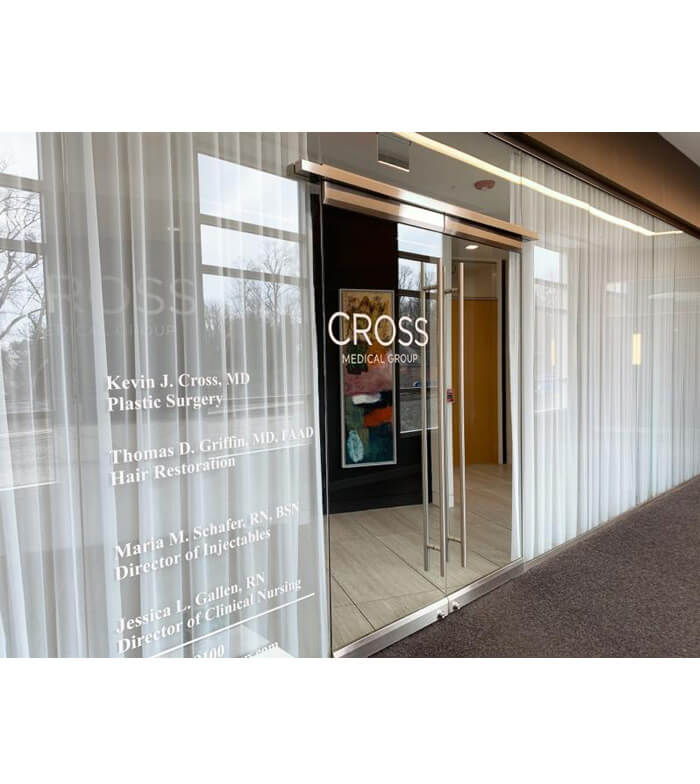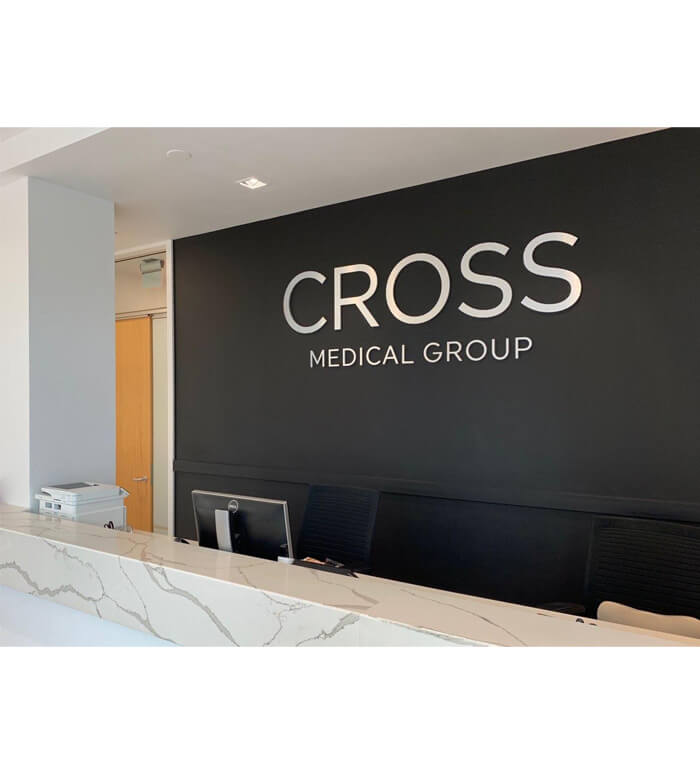Beard Transplant
Grow a Thicker and Denser Beard with Facial Hair Transplants
In most cultures, facial hair is associated with strength, maturity, and masculinity. A lack of facial hair or the inability to grow a thick, manly beard can be embarrassing for some men. Their hair might grow very slowly, become wispy rather than full, and have a sparse, patchy appearance instead of growing in a full, uniform way. Men dealing with this should know that hair transplants aren’t only for the scalp. They can also boost facial hair growth via a beard transplant at Philadelphia’s Cross Medical Group. Coupled with the recent trend of sporting a full beard, stylish mustache, or goatee, it’s easy to see why beard transplant treatments have increased in popularity over the past several years. With this in mind, our team offers beard transplant treatments for men who want to grow a more robust beard.
A beard transplant is a type of hair transplant performed to increase facial hair in the beard area. A similar procedure can be performed to increase sideburn and cheek hair if desired. In some cases, a beard transplant is used to conceal scars caused by acne, injury, burn, or surgery, or to hide discoloration.
What Affects Facial Hair Growth in Men?
Most men begin to develop facial hair during late adolescence, typically somewhere around 16 years of age. They typically begin to notice a little fuzz above the upper lip and on the chin during puberty, due to the effects of increasing testosterone levels, but it can take longer for the beard to reach its full potential. During the years of growth, it is normal for a beard to appear patchy as it grows in.
By their early to mid-20s, adult beard has (mainly) grown in, though the coverage may continue to thicken and increase during the 30s. If you have not been able to achieve a thick beard by your late 20s, it’s important to visit with Cross Medical Group to discuss a beard transplant.
Some men always have difficulty growing thick facial hair. Despite the common misconception, testosterone levels aren’t the only factor that affects how the hair grows in. Genetics are primarily responsible for dictating facial hair growth. Some men enjoy thick, full facial hair, while other men seem to grow very little at all, or experience pronounced patchiness in their beard growth patterns. In some cases, men experience facial hair loss, which can be caused by genetics, surgery, injury, or intentional removal of the hair (for example, laser hair removal or electrolysis).
Ethnicity, lifestyle factors, and autoimmune conditions like alopecia areata, which may cause unpredictable hair loss on both the scalp and beard, might also be contributing to poor hair growth on the face. Getting enough sleep, eating right, and exercising can help your beard to grow in better, but if those lifestyle choices haven’t helped, a beard transplant might be more effective.

SCHEDULE A CONSULTATION
Discover more about the benefits of a beard transplant in Philadelphia for growing a thicker beard without patches. Get in touch with Cross Medical Group of Philadelphia by calling (215) 561-9100, or submit a contact form o request a consultation.
How Are Beard Transplant Surgeries Performed?
A beard transplant can enhance facial hair growth. The objectives of a beard transplant will vary based upon the individual, but will typically involve thickening the beard area or filling in bald areas with hair taken from a donor area. The goal of the hair transplant is to provide a long-lasting and natural result that matches the pattern and texture of hair in the surrounding areas.
As with other hair transplant procedures, a beard transplant is performed in two parts, all on the same day. The first phase of this surgical solution involves harvesting the hair follicles from the back or side of the head. During the second phase, the harvested hair grafts are transplanted in the beard area.
Cross Medical Group will examine the hair on the back and sides of the scalp to determine which site offers hair that will be the closest match to the patient’s facial hair. Once the donor site is identified, our team will use one of two methods to harvest the hair follicles:- Strip harvesting: This beard transplant method involves removing a horizontal strip of skin and hair from the back of the patient’s head. The incision site is then carefully sutured to reduce scarring. Longer hair typically conceals the incision site well, but a small scar is unavoidable. Once the strip has been removed, Cross Medical Group carefully dissects the individual hair follicles and prepares them for transplantation.
- Follicular Unit Extraction (FUE): During follicular unit extraction, Cross Medical Group makes tiny, circular incisions on the back of the head to remove individual hair follicles one by one. These are then prepared for the beard transplant procedure. This method typically results in a much lower incidence of scarring, making it the preferred beard transplant method for many surgeons.
Once the grafts are ready, Cross Medical Group will carefully implant them in the designated area or areas on the face, such as the chin, upper lip, cheeks, and side of the face. To achieve an aesthetically pleasing result, our team must meticulously place each individual hair graft so that the angle and pattern of the hairs appear natural for the patient. The head area is given local anesthesia, and oral sedation is provided to prolong comfort during the treatment.
Who is a Good Candidate for a Beard Transplant?
Your skin and facial hairline will be assessed to determine whether a beard transplant is the right option for you. Most men with spotty or thinning patches in their beard area are suitable candidates for a beard transplant. The hairs on your scalp are commonly used for this surgery because they are very similar to your facial hair in texture and thickness. Patients will therefore need to have enough healthy hair follicles in the donor area at the back or top of the head to use for the beard transplant.
Beard transplant patients won’t need to worry about their hair being overly thin, as very few hairs are extracted and the reduction in the area is barely noticeable. If they already have male pattern baldness, the harvesting may cause them to have slightly less hair to cover their head when their loss reaches its more advanced stages.
Recovery and Results from a Beard Transplant
After surgery, the patient can return home. Cross Medical Group recommends that patients rest for about 24 hours after a beard transplant, but they can resume normal activities afterward. Small scabs or crusts will form around each of the transplanted hairs and will be present for about the first week following the beard transplant. As such, some men choose to take a few days off work to avoid appearing in public. While the scabs are present, it’s important to follow post‐operative instructions to promote proper healing. It’s normal to experience some side effects after a beard transplant—including mild bruising, swelling, and sensitivity—but patients usually won’t feel much pain.
More strenuous activities and exercise should be avoided for the next seven days. Once the donor and recipient areas have completely healed, it is important to protect the beard transplant areas from sun exposure to avoid discoloration. In around a week, you may be able to resume shaving and grooming as normal.
The results of a beard transplant are not seen right away. Two or three weeks after the beard transplant, the hair shafts will fall out, while the transplanted hair follicles continue to heal. They’ll regrow within three months and continue to get thicker and longer over the next 12 to 18 months. The hairs that are transplanted eventually grow in for good. Once all the follicles have begun growing, they will continue to grow for a lifetime. Beard transplant hair can be shaved and groomed exactly like normal facial hair.
How Much Does a Beard Transplant Cost?
The cost of a beard transplant depends upon the number of grafts required for the procedure. Patients wanting a dramatically thick beard will need more grafts than a patient who only wishes to fill in a bald or patchy area. You will be given a cost for your beard transplant during your initial consultation. It is possible that more than one beard transplant may be required, usually separated by at least six months.
SCHEDULE A CONSULTATION
Find out whether a beard transplant in Philadelphia is the best way for you to restore fuller facial hair. Get in touch with Cross Medical Group of Philadelphia by calling (215) 561-9100 or submit a contact form to schedule a consultation.








